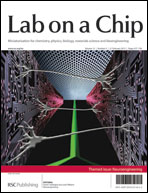Microfluidic technology is emerging as a useful tool for the study of brain slices, offering precise delivery of chemical factors along with robust oxygen and nutrient transport. However, continued reliance upon electrode-based physiological recording poses inherent limitations in terms of physical access, as well as the number of sites that can be sampled simultaneously. In the present study, we combine a microfluidic laminar flow chamber with fast voltage-sensitive dye imaging and laser photostimulation via caged glutamate to map neural network activity across large cortical regions in living brain slices. We find that the closed microfluidic chamber results in greatly improved signal-to-noise performance for optical measurements of neural signaling. These optical tools are also leveraged to characterize laminar flow interfaces within the device, demonstrating a functional boundary width of less than 100 μm. Finally, we utilize this integrated platform to investigate the mechanism of signal propagation for spontaneous neural activity in the developing mouse hippocampus. Through the use of localized Ca2+ depletion, we provide evidence for Ca2+-dependent synaptic transmission.

You have access to this article
 Please wait while we load your content...
Something went wrong. Try again?
Please wait while we load your content...
Something went wrong. Try again?


 Please wait while we load your content...
Please wait while we load your content...